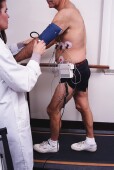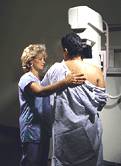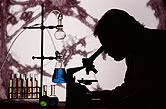
TUESDAY, July 29 (HealthDay News) -- Exercise testing has become a common part of cancer care and research, but most tests aren't administered according to American Thoracic Society guidelines, say Duke University Medical Center researchers.
In cancer care, exercise tests are used to determine the pre-surgical fitness of lung cancer patients. In cancer research, exercise tests are most often used to evaluate patients' cardiorespiratory fitness after a cancer diagnosis.
"We reviewed studies that performed exercise testing among adults with cancer and found most studies did not follow the guidelines recommended for clinical settings," lead author Lee W. Jones, an assistant professor of surgery, said in a Duke news release.
"We also found that studies typically do not report key physiological outcomes that provide immediate information on the fitness level in a particular cancer population or whether the test was valid," Jones said.
The findings were expected to be published in the August issue of the journal The Lancet Oncology.
A number of studies have concluded that exercise can benefit cancer patients before and after treatment.
"Several recent studies reported a strong association between increased levels of exercise and significant reductions in cancer recurrence and cancer mortality among patients with colon and breast cancer," Jones said. "As the level of evidence continues to grow, the need for exercise testing will grow in parallel."
Such tests need to be standardized to ensure safety and reliable results.
"We need to develop a plan for nationally and internationally mandated recommendations specific to the clinical and research applications of exercise testing for oncology patients," Jones said.
More information
The American Cancer Society has more about cancer patients and exercise  .
.

TUESDAY, July 29 (HealthDay News) -- The typical U.S. breast cancer screening strategy results in women being tested twice as often as a different approach use in Norway, but both are equally good at detecting disease, a new report says.
A study in the July 29 online issue of the Journal of the National Cancer Institute finds that a traditional physician- and self-referral screening strategy held up well against the Norway approach, in which the government sends letters to all women in a specific age range inviting them to have a screening mammogram. The Norway program aims for women to be screened every two years, while the U.S.-based "opportunistic screening" strategies advise women to have annual screening mammograms.
In comparing the strategies as applied to 45,050 women in Vermont and 194,430 women in Norway from 1997 to 2003, the researchers found that the age-adjusted screening detection rate of cancers was similar between the two populations (2.77 per 1,000 woman-years in Vermont versus 2.57 in Norway).
However, more than three times as many women in Vermont were recalled for further examination than in Norway (9.8 percent versus 2.7 percent).
When all cancers detected during regular screening and between screening mammograms were combined, no substantial differences were found in the prognostic features of invasive cancers detected in the two populations.
Given the shorter interval between screenings, the report's authors hypothesized that "Vermont women and/or their health care providers may more readily pursue evaluation of symptoms and clinical findings than their Norwegian counterparts."
"Our results demonstrate that despite its longer screening interval, the organized population-based screening program in Norway achieved similar outcomes as the opportunistic screening in Vermont," the team wrote.
More information
The U.S. National Institute on Cancer has more about breast cancer.

TUESDAY, July 22 (HealthDay News) -- Patients with stomach or pancreatic cancer may have more lymph nodes examined for the spread of cancer if they're treated at designated comprehensive cancer centers or at hospitals that do a high number of cancer surgeries, says a U.S. study.
If too few lymph nodes are examined for cancer cells, a patient's cancer may be incorrectly classified, altering prognosis, treatment decisions and eligibility for clinical trials, according to background information in the study. Current guidelines for stomach and pancreatic patients recommend examination of at least 15 regional lymph nodes.
The researchers examined National Cancer Data Base records of 3,088 stomach cancer patients and 1,130 pancreatic cancer patients. Of the stomach cancer patients, 11.6 percent had surgery at a hospital designated as a National Cancer Institute (NCI) comprehensive cancer center or as part of the National Comprehensive Cancer Network (NCCN-NCI hospitals), 34 percent had surgery at other academic hospitals (affiliated with a medical school but not designated as NCCN-NCI facilities), and 54.4 percent had surgery at community hospitals.
Of the pancreatic cancer patients, 19 percent had surgery at NCCN-NCI hospitals, 43.3 percent at other academic hospitals, and 37.7 percent at community hospitals.
"Patients undergoing surgery had more lymph nodes examined at NCCN-NCI hospitals than at community hospitals [median [midpoint], 12 vs. six for gastric cancer and nine vs. six for pancreatic cancer]," wrote Dr. Karl Y. Bilimoria, of the American College of Surgeons and Feinberg School of Medicine at Northwestern University in Chicago, and colleagues. "Patients at the highest-volume hospital had more lymph nodes examined than patients at low-volume hospitals [median, 10 vs. six for gastric cancer and eight vs. six for pancreatic cancer]."
Overall, 23.2 percent of stomach cancer patients and 16.4 percent of pancreatic cancer patients had at least 15 lymph nodes evaluated, the study said. Patients at high-volume or NCCN-NCI hospitals were more likely to have at least 15 lymph nodes examined than patients at community or low-volume hospitals.
The study was published in the July issue of the Archives of Surgery.
"Nodal status is a powerful predictor of outcome, and every reasonable attempt should be made to assess the optimal number of lymph nodes to accurately stage disease in patients with gastric [stomach] and pancreatic cancer," the researchers wrote. "Moreover, differences in nodal evaluation may contribute to improved long-term outcomes at NCCN-NCI centers and high-volume hospitals for patients with gastric and pancreatic cancer."
More information
The American Cancer Society has more about stomach cancer  .
.

SUNDAY, July 20 (HealthDay News) -- A sweeping genetic analysis suggests that the activity of certain genes might someday allow doctors to predict which lung cancer patients need more aggressive therapies and which do not.
But the findings also underscore the difficulty of making such predictions, especially in the case of people with the earliest forms of the disease, when aggressive therapies could be of greatest value.
The goal is to build effective predictors based on gene expression (activity) and use them prospectively to guide treatment decisions, experts said.
However, to do that, "you have to know what are the potential issues that might influence how well gene expression might predict," said researcher David Beer, a professor in the department of thoracic surgery at the University of Michigan. "I guess the bottom line from this study is that because of the heterogeneity of lung adenocarcinoma, it is not an easy problem. There are still significant issues."
Still, this study -- the most comprehensive yet to date -- could pave the way to more tailored lung cancer treatment based on gene expression profiles, said one expert.
"The goal is five years from now, if I had this data on a stage 1 or stage 2 lung cancer patient, that I could say, 'Hey, you have a very low-risk profile, you don't need chemotherapy' and vice-versa, of course," said Dr. Edward Kim, an assistant professor of medicine in the department of thoracic/head and neck oncology at the University of Texas M.D. Anderson Cancer Center, in Houston.
"It is no different from what we do for breast cancer, where we use certain markers to help doctors make decisions about what treatment they need," Kim said. "This is a step in that direction for lung cancer."
The results were published online July 20 in Nature Medicine.
Beer, along with James Jacobson of the U.S. National Cancer Institute, led the study under the auspices of the NCI Director's Challenge Consortium for the Molecular Classification of Lung Adenocarcinoma, which also includes researchers at the H. Lee Moffitt Cancer Center in Tampa, Fla., the Memorial Sloan-Kettering Cancer Center in New York, the Dana-Farber Cancer Institute in Boston, and the Ontario Cancer Institute in Canada.
The consortium first compiled 442 lung adenocarcinoma samples from six institutions and then divided them into four test sets. For each sample, they collected gene expression data on some 22,000 genes found in these cancer samples. They also looked over clinical information, such as the stage of the cancer and the patients' outcomes.
Consortium members then used two of the test sets, including outcome data, to develop prognostic "classifiers" -- collections of genes whose changes in activity (expressing or producing proteins, for example), whether up or down, predict patient outcome.
Then, the researchers applied these classifiers -- eight were developed overall -- to the remaining two test sets in a so-called validation step. Unlike during the initial "training phase" of the study, patient outcome data at this stage was "blinded." That meant that the researchers had to let their gene signatures (with and without the aid of clinical data) predict patient outcome. Those predictions were then checked against the actual clinical data to measure their accuracy.
The results, said Beer, were mixed.
"We found some [classifiers] work well on one test set but not both, and very few worked well on both, and some of the published signatures did not work very well at all," he said.
Performance was better for tumors of all disease stages than when focusing exclusively on stage 1 disease, he noted. But, in most cases, the addition of clinical data substantially improved the predictions.
For Beer, the data highlight the difficulties of working with such a variable disease as lung cancer, which stems from both genetic and environmental (i.e., smoking) factors.
"It would be wonderful if this was very easy, and you could do it very accurately, but in reality it doesn't work as well as hoped, and we are trying to understand why that is the case," he said. "Why does it work well in some patients but not in others? How do you improve it? How do we identify genes that are prognostic for everybody, or at least for specific subgroups of patients?"
But Dr. Arul Chinnaiyan, a cancer microarray expert at the University of Michigan who was not affiliated with this research, praised the study's design -- particularly its size, use of blinded samples, and multi-institutional format. He also applauded the team's ability to develop and identify gene signatures that work across the various testing sites.
"Many biomarkers as developed often don't hold up across institutions," he said. "Early on, studies are done in an unblended way, at one institution. Often, when another researcher does this, it doesn't validate. That is what is so impressive, that it held up at all these institutions. That points to the robustness of the signature they identified, that it probably will hold up in a clinical setting."
Kim agreed that the study's strength lay in its numbers.
"This is extremely important [work] because they brought everyone together, they have 442 samples for which they have very good gene expression data and clinical data," he said. "And the goal is to grow this so it can be used in a prospective study and hopefully, then, be integrated into our daily clinical practice."
According to Chinnaiyan, the new data suggest that a lung cancer prognosis, like that of breast cancer, could be predicted from gene expression data via a diagnostic test. Two clinical tests, Agendia's MammaPrint and Genomic Health's Oncotype DX, already use the expression of 70 or 21 genes, respectively, to predict which breast cancer patients are likely to suffer a recurrence of disease, and thus might benefit from more aggressive therapies.
The hope is that similar strategies might work for an even bigger killer, lung cancer.
"This is very analogous," Chinnaiyan said.
More information
For more on lung cancer, visit the American Lung Association  .
.